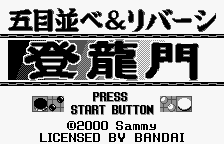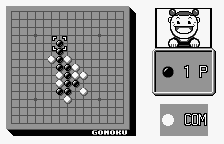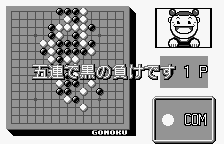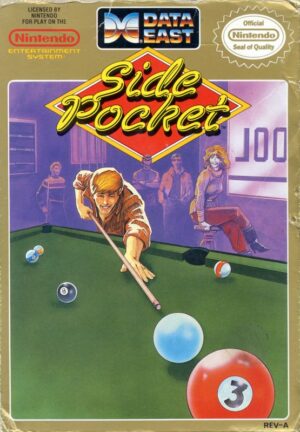Retro Replay Review
Gameplay
Gomoku Narabe & Reversi Tōryūmon offers two venerable board games in one cartridge, each with straightforward rules but deep strategic potential. In Gomoku Narabe, you and your opponent take turns placing black or white stones on a 14×14 grid, aiming to connect five in a row while thwarting any attempts to do the same. The simplicity of “five stones in a row” belies the tactical layers that emerge as the board fills, demanding both offensive foresight and defensive vigilance.
Reversi (also known by its popular name Othello) switches the action to an 8×8 board, where flipping your opponent’s pieces by sandwiching them between your own leads to dramatic turns of momentum. Early skirmishes feel calm, but mid-game battles often see massive swings in tile control, forcing you to constantly reevaluate the best spots to claim. The game’s pacing encourages careful planning—one misplaced move can hand the initiative to your rival.
Beyond standard free-play, the title’s Challenge Mode adds a progression ladder of quirky opponents. You’ll start by facing off against a grinning goblin, then ascend through a series of increasingly formidable masters, concluding your journey under the scrutiny of a mysterious old guru. Each new adversary brings slightly different opening patterns and AI tendencies, making the climb feel like a true test of skill.
Multiplayer is supported via the Communication Cable, enabling head-to-head matches in both Gomoku and Reversi. While it’s curious that two-player action requires a link rather than passing the same system back and forth, this setup ensures each player has an uninterrupted view of the board. The connection is straightforward, and once linked, the pace of matches feels fluid and competitive.
Graphics
Visually, the game embraces a clean, minimalist aesthetic optimized for clarity on a small screen. The 14×14 and 8×8 grids are rendered with crisp lines, and tokens—solid black or white stones—stand out clearly against the background. There’s no unnecessary ornamentation, which keeps your focus squarely on the board and your next move.
Character portraits appear between rounds in Challenge Mode, offering a splash of personality without overwhelming the puzzle-based action. A sneering goblin, a stoic samurai, and other challengers are sketched in simple monochrome art, giving each encounter some narrative color. These drawings may be rudimentary, but they help break the monotony of blank boards and hint at each opponent’s attitude.
Animations are limited to subtle stone placements and tile flips, but each is executed with satisfying snappiness. When a tile reverses in Reversi, it quickly “flips” over in a clean transition, reinforcing the impact of your move. On the whole, the graphical presentation is functional rather than flashy, but it never obscures the essential gameplay.
The interface menus are logically arranged, allowing you to choose between game modes, difficulty levels, and two-player linkage with ease. All text is legible, and navigation cues are straightforward—even beginners will quickly find their way through the options.
Story
Though Gomoku Narabe & Reversi Tōryūmon is primarily a puzzle compilation, it weaves a loose narrative thread through its Challenge Mode. You begin your journey as an upstart board player facing a mischievous goblin, whose wide grin belies his cunning openings. From there, each victory propels you to the next challenger—a spectrum of personalities from boastful braggarts to solemn strategists.
As you climb the ranks, the implied “tōryūmon” (passing the dragon gate) theme comes alive: each victory feels like clearing another hurdle on your path to mastery. While there’s no expansive plot or dialogue beyond brief opponent taunts, the roster of characters lends a light sense of progression. Defeating a spunky young expert feels as rewarding as conquering the ultimate guru at the peak of difficulty.
Interspersed between matches are minimal text prompts, offering encouragement or sly jabs from your adversaries. The lack of an elaborate storyline means your personal investment comes purely from rising through the ranks and outsmarting the AI. For fans of board-game lore, this stripped-down approach places all the emphasis on sheer tactical skill rather than long cutscenes or verbose exposition.
Overall Experience
Gomoku Narabe & Reversi Tōryūmon delivers two timeless puzzle experiences in one portable package. Whether you’re a newcomer seeking approachable brain teasers or a seasoned player hungry for strategic depth, both games offer hours of thoughtful play. The dual-game format provides variety, allowing you to switch gears between the linear goal of Gomoku and the dynamic tile-flipping drama of Reversi.
The AI challenge curve is well calibrated: early foes help you learn the fundamentals, while higher-ranked masters exhibit sharper tactics that will test even veteran players. The addition of multiplayer via Communication Cable further extends replayability, offering spirited duels with friends and rivals alike. Though requiring a link cable may seem outdated, the direct head-to-head competition feels rewarding and immediate.
Visually and narratively, the game keeps things concise and to the point, prioritizing function over flourish. Character portraits and brief taunts inject just enough personality to break the puzzle loop without bogging down the pace. If you prize clean presentation, solid challenge progression, and the pure joy of outthinking an opponent, this compilation is a worthy addition to your collection.
In sum, Gomoku Narabe & Reversi Tōryūmon is an excellent choice for anyone who enjoys classic board-game mechanics in a handheld format. Its straightforward packaging hides a wealth of strategic nuance, offering both solo and multiplayer thrills wherever you go.
 Retro Replay Retro Replay gaming reviews, news, emulation, geek stuff and more!
Retro Replay Retro Replay gaming reviews, news, emulation, geek stuff and more!









Reviews
There are no reviews yet.